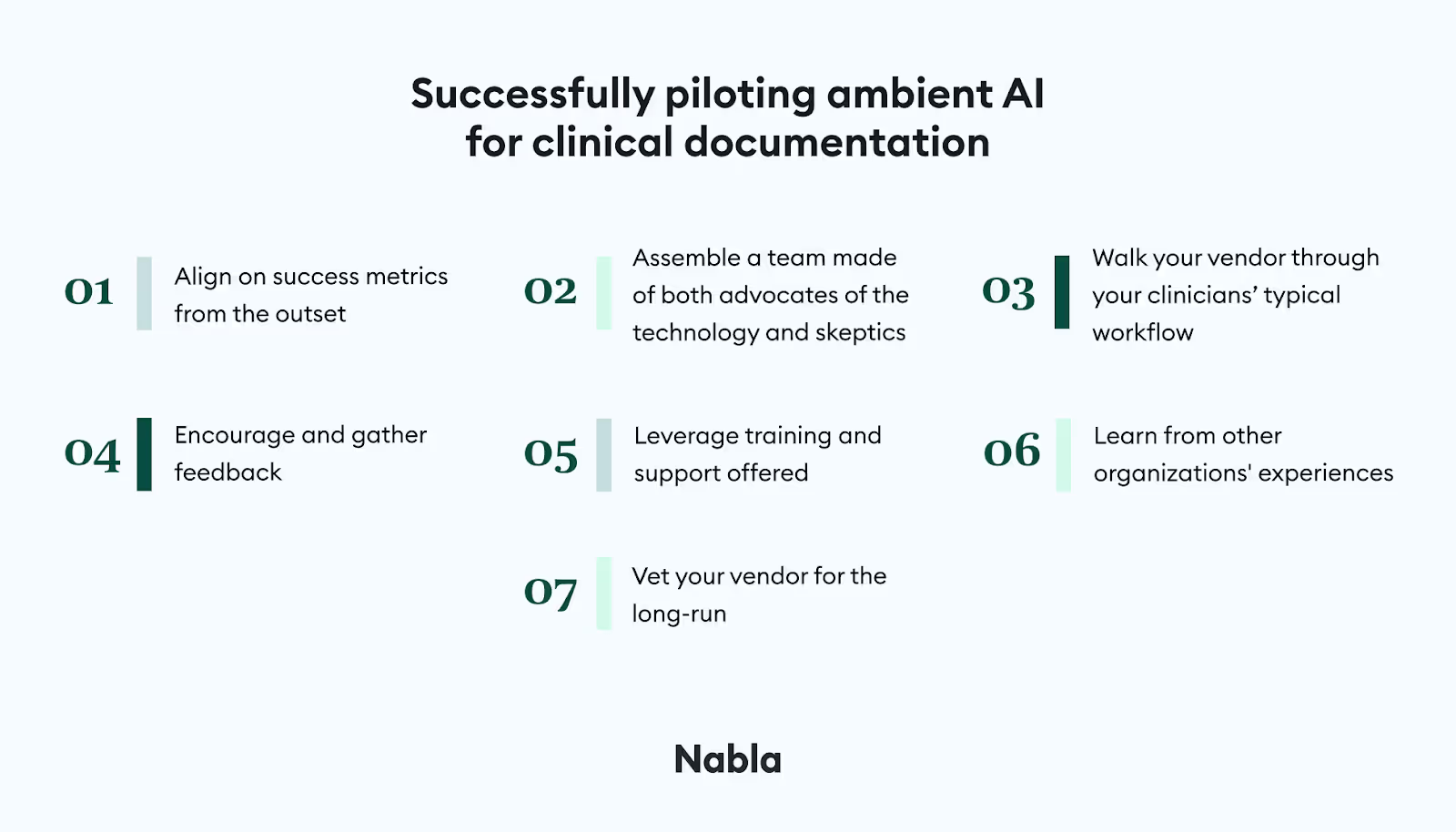Successfully piloting ambient AI for clinical documentation
Implementing new technology in organizations is like navigating a ship through uncharted waters – it requires a steady hand and a good map. When the hype is intense, and the stakes are high, understanding what’s worked for others can exponentially increase your chances of success.
This year, ambient AI for clinical documentation has arguably been the most talked-about topic in AI for healthcare. It’s both natural and wise for health system leaders to pilot a solution before implementing it organization-wide.
Over the past 18 months, Nabla has been piloted in over 80 organizations. We’ve had the privilege of collaborating with pioneers at organizations such as Children’s Hospital of Los Angeles, Kaiser Permanente, Stratum Med clinics, Carle Health and many others, all of whom have been exceptional partners. We have worked side by side with CMOs, CMIOs, CIOs, and their teams. For each and every one of these pilots, we have made it a priority to:1. Partner to define the success criteria for each organization.2. Comprehend the unique clinical workflow of our users, and how Nabla could seamlessly fit into that workflow.3. Provide white glove support through tailored training, onboarding and feedback loops with each of the pilot participants.4. Track the impact and adoption of our product, so our partners could make informed decisions on the next steps for implementation.
When considering what’s worked best for the first organizations who successfully piloted and rolled out Nabla, 7 key actions stand out.

1. Align on success metrics from the outset
Collaborate closely with your vendor to establish a shared vision of success for the pilot and strategies to achieve those metrics. Discuss the data they can contribute to facilitate evaluation and work together to integrate data from additional sources such as your EMR to provide a comprehensive overview.
Establish regular evaluation periods that will give you the chance to correct-course during the pilot program. Share the metrics you’ll be tracking with pilot participants and ensure they provide the answers you need for measurement.
★ Pro-tip: If you’re looking for a long-term partner, and want to avoid going through failed pilots, or pilots with weak adoption, make sure you start these conversations as early on as possible with the vendor. If the vendor is interested in your success, they will go above and beyond to support your success metrics.
2. Assemble a team made of both advocates of the technology and skeptics
Identify the AI champions that are passionate about the technology and who will commit to using it during the pilot. They should be eager to provide valuable, detailed feedback and be curious about the technology and its range of applications. Ensure that this power users group conducts enough encounters during the pilot period to thoroughly test the limits of the technology, or even attempt to "break it," as some CMOs like to joke. Including skeptics in the team will provide alternative perspectives, help identify potential challenges, and promote a comprehensive evaluation of the technology.
★ Pro-tip: We usually recommend that at least 50 people take part in a pilot for organizations over 500 providers, for several weeks.
3. Walk your vendor through your clinicians’ typical workflow
Ensure the tech works for the clinician and not the other way around. The less the participants feel they have to change their ways of working to use the AI, the more likely it is they will adopt it. Can the vendor customize the product to your clinicians’ needs? Nabla has become a key partner to numerous organizations thanks to our strong focus on customization, adapting the product to a wide array of workflows.
★ Pro-tip: Share your typical clinical workflows with the vendor and involve them in the clinicians' chart review process. The aim is to avoid imposing excessive changes on physicians' workflows.
4. Encourage and gather feedback
Ask your pilot group to take the time to provide feedback and reflect on how the product could be improved. Provide ways and opportunities that make it easy for them to share this feedback: through forms, regular touchpoints, office hours, etc.
Encourage your team to provide candid and thorough feedback. This is where the magic happens, as even small changes can significantly enhance the solution and transform their entire workflow.
★ Pro-tip: Work with a vendor that’s quick to implement changes and updates, and who has the capacity to support your power users during the pilot in a timely and effective way. This will be a key indicator of whether they can support a larger roll out and maintain a long-term partnership with your organization.
5. Leverage training and support offered
Check with your vendor whether or not they will offer the kind of training and support that your organization will need. “Train the trainers” can be useful to quickly get some individuals up and running with ambient AI so they can mentor others. Office hours provide dedicated time to answer specific questions and offer personalized guidance. Co-build a resources hub where pilot participants can find an onboarding guide and a FAQ.
★ Pro-tip: We’re keeping this one to ourselves ;) but we’re happy to share more if you reach out.
6. Learn from other organizations' experiences
As an organization, you understand your group's needs and your providers' requests better than anyone. However, given the rapid market evolution and widespread discussion about ambient AI, consulting colleagues at other organizations about their approaches can be valuable. If your budget permits attending, many healthcare conferences now focus on real-world use cases of ambient AI applications.
★ Pro-tip: Connect with peers who have undergone similar pilot or deployment processes. Ask about their success criteria, whom they evaluated, and what they liked or disliked.
7. Vet your vendor for the long-run
Buying ambient AI software is similar to purchasing any other healthcare software. Consider these questions:- Can I envision a long-term relationship with this vendor?- Does the vendor’s roadmap align with my organization's long-term ambitions?- Will the vendor demonstrate agility and responsiveness to meet our clinicians’ needs, ensuring seamless adoption?- Is this vendor financially viable for my organization? - Does this vendor have a successful track record?
★ Pro-tip: Thoroughly research your vendor. Ask for use cases and client references, understand and examine their five-year vision. Ensure they have the product and engineering expertise to support rapid innovation in AI, or you may face frustration in a few months.
Connect with our team to learn more on how to implement Nabla at your organization.



